Posted by Igo Licht on 08-25-2004 07:14 PM:
Two Baluch Prayer Rugs
Hi to all,
I have two camel ground, tree-of-life Baluch prayer rugs. The
first one is presented below.

It has great colors, smooth
shiny wool, some wear of possible use (knees?). Its handle is not very soft and
its knot density is typical to Baluch rugs ( v 9, h 7 / inch). The knot
structure is ASL. It has multiple borders usually associated with later Baluch
rugs but its clear and balanced field design (only four branches on each side of
the tree) points to an earlier date. It was one of our first Baluch rugs and we
enjoyed it much. The rug was even considered to be good enough to make into
Frank Diehr’s Baluch selection (Treasured Baluch Pieces from Private
Collections, 1996, plate 84). Conventional Baluch dating places the rug in the
later quarters of 19th century.
The second Baluch, although having the
same basic design elements of tree-of-life camel ground prayer rug, is a quite
different rug. As you can see it is not in great condition, with the upper right
part missing.
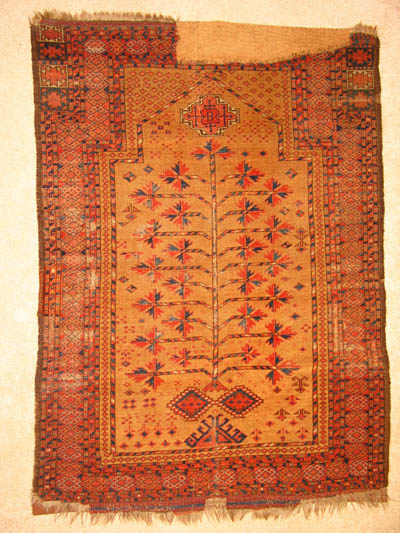
The rug includes a much clearer telationship to Turkoman
weavings:
1. half a Dyrnak gul at the bottom,
2. a complete complex gul
at the top,
3. multiple borders with Ersari (Beshir) elements and color
tonality
It also includes an interesting “sloping shoulders” barber pole
border that encircles the entire main field. The handle of the rug is softer,
color tonality is quite light for a Baluch. The knot structure is also ASL, with
finer density (12 v, 8 h /inch). The estimated age based on Michael Craycraft’s
statement – end of the 18th century/beginning of 19th century (based on its
strong Turkoman influence and lighter colors), makes it one of the older
surviving Baluch rugs.
Visually, the biggest difference between the two
rugs lies in the very open, spacey design of the second rug versus the
relatively crowded design of the first one.
Regards,
Igo
Licht
Posted by Patrick Weiler on 08-26-2004 01:50 AM:
Stunning
Igo,
Your first piece would be a prize in many collections. Your
second piece is a knockout!
A very unusual feature of that second rug is the
lack of symmetry in designs between the left and right sides in regard to the
filler motifs. Even the mihrab diamonds are less crowded on the right than the
left.
Perhaps both wives wove it at the same time, one on the left
(democrat?) and one on the right (republican?)
Notice the ashiks in the upper
left and right borders. They are the same as in a small Uzbek chanteh shown on
the first page, halfway down, of salon 84:
http://www.turkotek.com/salon_00084/salon.html
Was this
rug woven by committee?
Patrick Weiler
Posted by David R.E. Hunt on 08-26-2004 09:47 PM:
Do We Have A Match?
Igo and All- Like both of your rugs, especially the second. But am curious,
is this surely a Balouch? Compare it to an image of a Beshier prayer rug as
below. Also, you might enjoy taking a look at my Balouch prayer rug, as seen
here on Turkotek - Dave
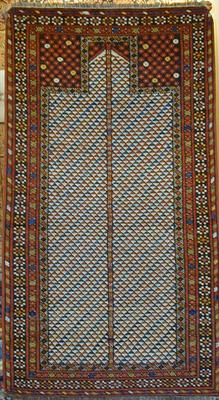
Posted by Filiberto Boncompagni on 08-27-2004 12:03 PM:
quote:
Your first piece would be a prize in many collections. Your second piece is a
knockout!
I agree with Pat. I am also impressed by the Mirhab of the
second one. Quite unique for a Baluch.
Congratulations!
Regards,
Filiberto
Hi John,
Posted by Steve Price on 08-27-2004 12:09 PM:
Hi Filiberto
The mihrab is similar to those on the so-called
Dokhtor-i-Gazi prayer rugs, a peculiar subgroup of the Belouch group.
Regards
Steve
Posted by Igo Licht on 08-28-2004 12:05 AM:
Steve, Pat, Filiberto,David,
1. Happy to hear that you like the
rugs
2. Pat: I agree with a lack of symmetry in fillers but it does not
affect the overall symmetry of the rug. You are right about the same ashik used
on your referenced chanteh, although I had difficulty recognizing it at first
because of its reciprocal design.
3. David: Was this woven by a Baluch? I
used the Baluch name here in a wider, design type sense. I don’t think we know
for sure who wove these rugs. Brian McDonald shows a rug (Plate 163, “Tribal
Rugs”) which I believe belongs to the same group and writes: “ The structure,
colours and border designs indicate to me that this tribe inhabited the
border-lands between north-eastern Persia, north-western Afghanistan and Central
Asia. The archetypal “gol” within the prayer niche at the top of the tree is
peculiar to this group, and indicates a possible link with their Turkmen
neighbours. It is quite possible that, with this type, we are looking at the
oldest and perhaps even a prototype, of the camel hair “Baluch” prayer rugs”.
Side by side comparison of your Baluch and my first rug shows similarities
in all design elements of the rugs (hand panels, borders, some of the filler
elements, and more). It looks as if the weavers of these two rugs have drawn the
design elements from the same design pool, giving them different individual
interpretations. The colors and the palette are different, mine are darker and
with no white in the field. Your rug also looks finer, with more detailed
drawings. I am not sure how to compare the age of these two rugs. Another
example of the same type is shown on plate # 28 in Michael Craycraft’s Prayer
Rugs book.
4. Filiberto, Steve: The sloping mihrab indeed resembles the
Dokhtor-i-Ghazi sub-group, but the rest of the design elements are quite
different.
Regards,
Igo Licht
Posted by Filiberto Boncompagni on 08-28-2004 03:58 AM:
Hi Steve,
Similar to "the so-called Dokhtor-i-Gazi prayer
rugs"?
Yes and not. Let’s see and compare.
The two rugs from the left
in the following image belong to the V&A Museum.
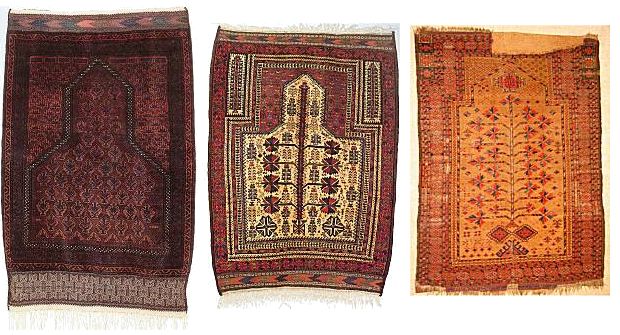
The first one is a so called
Dokhtor-I-Ghazi.
The second one looks like a transition from the
classical Baluch prayer rug and the Dokhtor-I-Ghazi. In its own is quite unique,
I guess. The mirhab is very similar to the latter.
The third is, of
course, Igo’s rug. The mirhab is not terribly similar, in my opinion.
It
could be very well the ancestor of the camel hair "Baluch" prayer rugs.
Regards,
Filiberto
Posted by Steve Price on 08-28-2004 08:31 AM:
Hi Filiberto
I don't think the Dokhtor-i-Gazi in your post is a
typical classic form. The field design is the one they use, but the mihrab
arrangement looks much more recent to me.
Here's what I had in mind when
I said I saw some similarities between it and Igo's fragment.
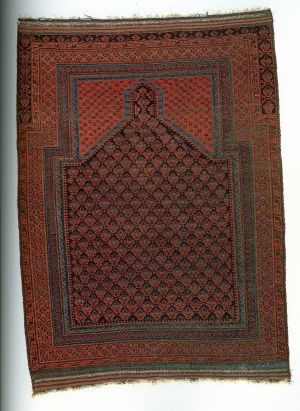

The similarities that
struck me are:
1. The "mihrab-within-a-mihrab", albeit of very dissimilar
proportions.
2. The treatment of the spandrels.
3. The main
border.
Regards
Steve Price
Posted by Filiberto Boncompagni on 08-28-2004 10:49 AM:
Hi Steve,
Can’t distinguish well the main border in your picture, but
I agree with your points 1 and 2.
Regards,
Filiberto
Posted by David R.E. Hunt on 08-28-2004 08:26 PM:
Kindered Spirits
Dear Igo and All-
I rembered this piece from Thomas Cole's website.
Quite similar, and can recall a couple with this same or similar colors yet
different designs/drawing.
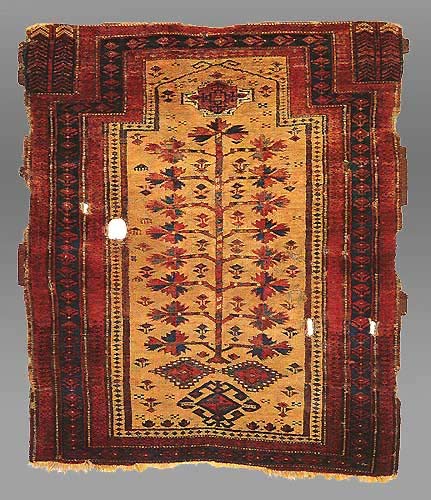
Mr Cole states that
"The weave pattern is very much like
that of a fine Ersari weaving as is the handle of this very rare prayer rug,
suggesting the Turkmenistan provenance"
Also, the proportions of the
mihrab do remind some of some Beshir prayer rugs (Doktor-I-Ghazi too), the above
not the best representative example of this relationship,yet my most similar rug
image has come up lost for now(I'll keep looking).
Now this rams horn at
the apex, could it be a vestigal/interpretive example of this?
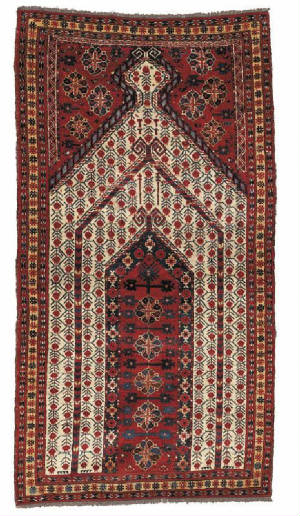
This other
example of said Beshir prayer may seem somehow familiar,especially the
shrubs.
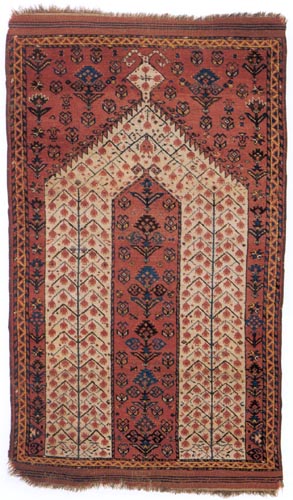
There are a multitude of tree of life interpretations, many of
which, it is my impression, are somehow rather closely related, as evidenced
by
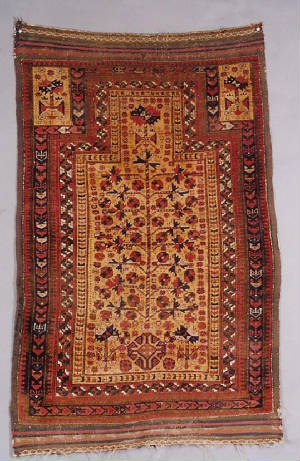
as compared to my rug,which for
conveinence,
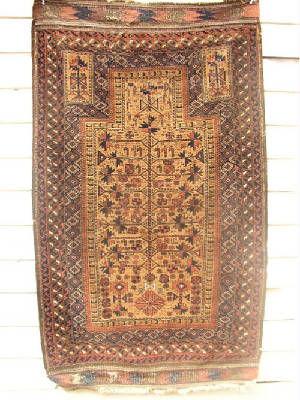
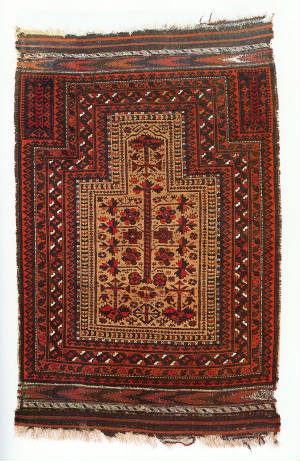
as well as the above mentioned plate #28 from Balouch Prayer
Rugs.
How does your rug figure into these
relationships?

My guess would be that these two groupings of rugs, those of
supersaturation which include plate #28 and your rug,and these drab
pieces,represent the works of different peoples/materials. Or do they?
As
to age, this from Murry Eiland and Pacific Collections:
"Wilber's
earliest(Balouch) listing is a bagface dated 1904", and
"there are a few
features of color and design that suggests greater age for certain(Balouch)
rugs.Pieces that seem earlier often show a greater range of color and perhaps
generally lighter tones. In earlier pieces there is more likely to be a light
blue as well as a dark blue, and the reds may veer more toward rust shades than
deep reddish browns."
Also,
"But does it really make much
difference? Probably not,as the rugs began to show western influence even later
than in most parts of the weaving areas."
Find here a link to the de
Young Museum and some Baluch prayer rugs from the McCoy Jones CollectionMcCoy Jones- Dave
Posted by Filiberto Boncompagni on 08-29-2004 02:35 AM:
Hi Dave,
Very interesting, especially the photo of Thomas Cole's
rug.
Keep on looking.
Regards,
Filiberto
Posted by David R.E. Hunt on 08-29-2004 09:43 PM:
Took Me A While...
Igo and All- I have found the above mentioned image of an Ersari prayer rug
with a mihrab of similar proportions to your old fragment, and a second carpet
of similar proportions on Turkotek.
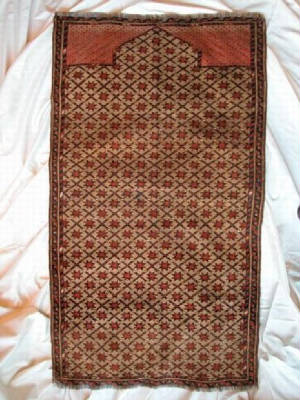
-Dave
Posted by Ralph_Kaffel on 08-30-2004 06:25 PM:
I have some notes about Igo Licht's prayer rug. It belongs to a very rare
type of Beluch, of which less that a half dozen examples have been
published.
In what may have been the earliest publication of any type of
Beluch prayer rug in color, Werner Grote-Hasenbalg illustrated his example in
"Der Orienttepich" (1922) Volume II, plate 48, which he estimated to be aged
40-50 years. That would equate to 1872 -1882, which I think was on the cautious
side. While Hasenbalg attributed his rug to "Beluchistan", he wrote that the
natural camel hair was from a Persian dromedary, and the dark brown color from
the wool of a two-humped Asiatic camel!
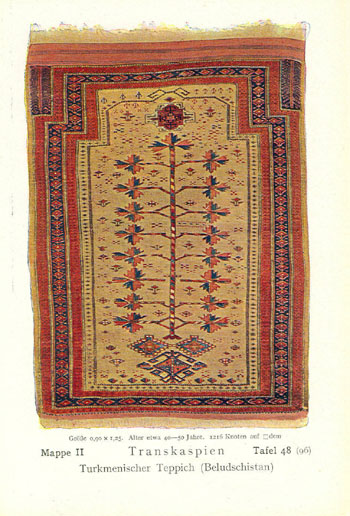
A second, very similar example was
published twice by Bausback, (catalog 1976, pps.216/7, and catalog 1978,
pps.404/5), attributed to East Persia/Meshed, and dated to first half 19th
century.
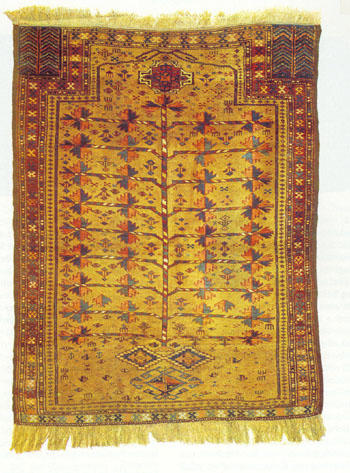
The
third example was cited by David R.E. Hunt,( Hali 97, p.89).
Two other
related examples, Bausback 1979, p.117/Bausback Beluch 1980, p.9 and Brian
McDonald "Tribal Rugs", pl.163, lack the secondary sinuous tracery prayer arches
of the other three. It should be noted that when Igo's rug was published by Hans
Elmby in his Turkmen Catalog #4 (1998) plate 59, it was attributed to
Ersari/Beshir, before 1850. Elmby wrote, in part, "The similarity to Belouch
work is astonishing, however the structure is different just as the reverse does
not resemble Belouch".
Regards,
Ralph
Posted by Igo Licht on 08-30-2004 06:38 PM:
Brian MacDonald's rug
Here is the image of Brian MacDonald's rug (plate 163) that was mentioned in
previous posts.
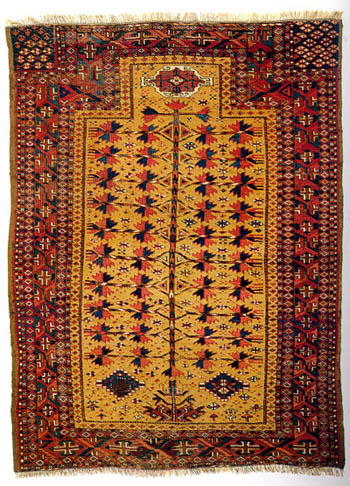
Igo Licht
Posted by Filiberto Boncompagni on 09-01-2004 03:22 AM:
Thank you all for your additional images and references.
That’s what makes
threads like this the salt of Turkotek, IMHO.
So… Initially Igo’s rug
wasn’t identified as a Baluch!
Best regards,
Filiberto
Posted by David R.E. Hunt on 09-10-2004 04:18 AM:
Ersari Examples
All- Find below a couple of examples of Ersari prayer
rugs-Dave
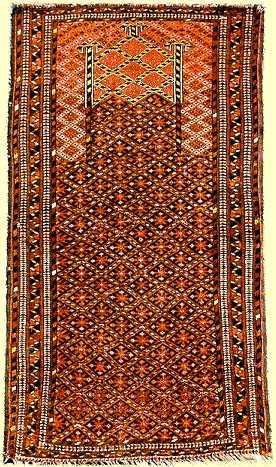
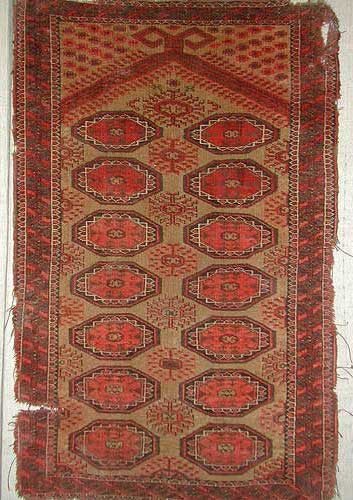
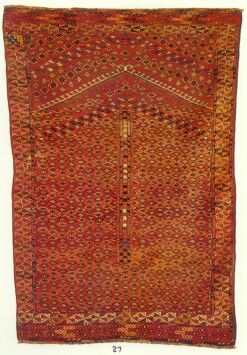
Posted by Richard_Farber on 09-10-2004 09:21 AM:
dear contributers,
perhaps one or two of you might get together and do
a salon [or mini salon] on the balcuh and related prayer rugs . . . .
i
for one would be most interested
thanks in advance
richard
farber
Posted by Steve Price on 09-10-2004 09:24 AM:
Hi Richard
Mark Hopkins wrote a wonderful article about Belouch group
prayer rugs in HALI a few years ago, and Michael Craycraft has a nice little
book devoted to the subject. So the starting material for a good Salon is in
place. Any volunteers?
Regards
Steve Price
Posted by DavidR.E.Hunt on 09-15-2004 06:08 AM:
Will do

















